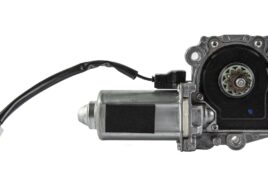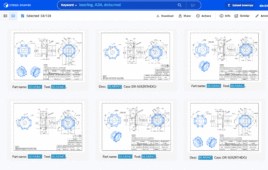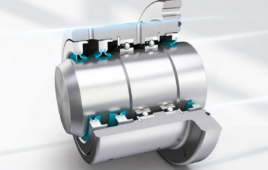Blower trucks pneumatically apply seed, straw, mulch, pea gravel and other turf maintenance media. Typically, the media are dispersed through a pneumatic applicator fed by powered augers and conveyors in the truck bed. But there are times when operators must access the truck interior, usually through a rear hydraulic lift gate. Until recently, this gate was operated by two persons, one operating the hydraulic power unit and another climbing under the open gate to set a steel prop rod into place. The door would then be lowered into contact with a mechanical stop to hold the door open at various heights for troubleshooting, routine maintenance and media inspection. The lift gate is powered by dual-acting hydraulic cylinders, swinging the gate up and down in a 65º arc.

Express Blower truck, built by Finn Corporation of Fairfield, Ohio. Hydrotech, an AMLOK distributor, raised the possibility of using the AMLOK rod lock to hold the rear lift gate in position.
At one point, the developer of these trucks, Finn Corp., explored mechanically locking the cylinder rods in place automatically without using the prop rod and losing hydraulic pressure. But another device solved the problem. The combination of an AMLOK rod lock, rod and rod eye, plus cartridge valves and bodies supplied by Hydrotech engineering staff resulted in a system that mechanically holds the lift gate securely at any angle, with rod release occurring on operator command.

Close-up shows the AMLOK rod lock (on far right in photo), provided by Advanced Machine & Engineering, that mechanically locks the massive lift gate into position, in the event of a hydraulic pressure loss. The rod lock mechanically disengages on re-energizing of the system.
The system is a “power off” mechanical rod lock. If the directional valve is de-energized, the hydraulic hose breaks, or other loss of hydraulic pressure occurs, the rod lock mechanically holds the rod in place, securing the lift gate position. A shuttle valve is used, since the cylinders are double acting, to feed the pressure side to the directional valve. In normal operation, when the valve is energized, the rod lock releases.
Now, only one operator is required to raise and lower the lift gate.
Advanced Machine & Engineering Inc.
www.ame.com
::Design World::
Filed Under: Hydraulic equipment + components, Automotive, FLUID POWER, Off highway • construction • agriculture





Tell Us What You Think!